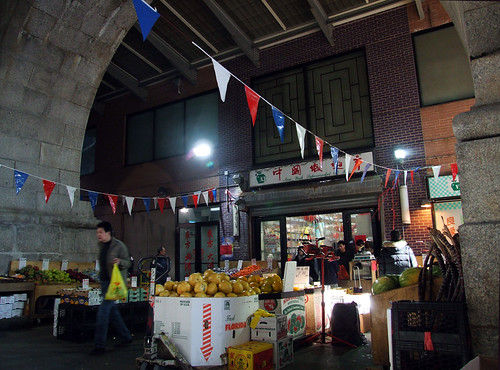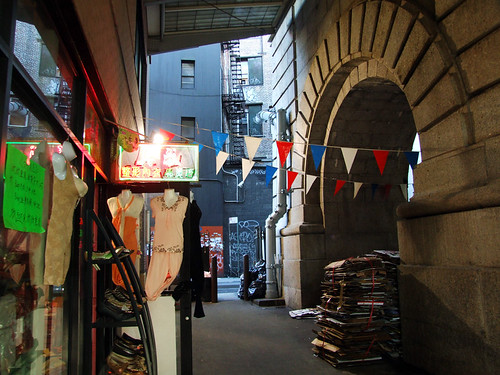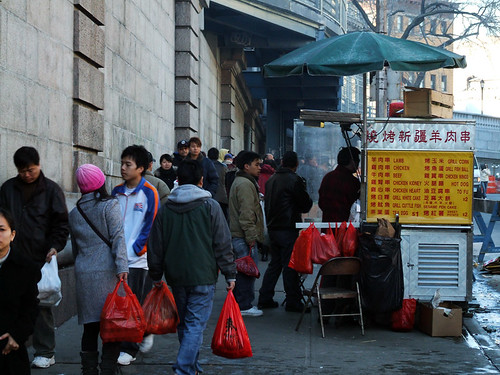It’s a bit of a paradox — bridges are meant to connect two sides of a gap, to bring them together, but they often act quite intentionally as barriers because the space beneath them is so problematic. There is a tendency to leave it unused and overgrown with weeds, or to give it up for some perfunctory use, like parking.
But there are many creative solutions to dealing with the space underneath a bridge. I came across one of them when I walked under the Manhattan Bridge in New York’s Chinatown. Shops, retail arcades and produce stalls occupy the space beneath its stone arches; a fruit and vegetable market winds its way up the sidewalk along the north side of the bridge. Instead of dividing a neighbourhood in two, the bridge serves as a focal point for Chinatown.
When I posted about this on Urbanphoto earlier this week, a couple of commenters drew parallels to the CN Rail viaduct in Griffintown, which houses CN offices and private storage units under the tracks. It would be interesting to consider some more engaging uses for the space under the viaduct, especially as Griffintown is poised for redevelopment.
There are other elevated structures in Montreal with wasted space underneath. The Jacques Cartier Bridge is one; although a nice plaza was recently built where the bridge crosses Ste. Catherine Street, the land beyond that is still empty and used for parking. Why not a soccier field or some green space, like under London’s Westway? Same for the Notre Dame Street viaduct east of Old Montreal. It passes through a newly-built residential area lacking in retail and neighbourhood amenities; the viaduct could provide shelter for a weekly farmer’s market.
Let’s hear from you. If the discussion that emerged after I posted about the Van Horne viaduct is any indications, Spacing readers have some interesting ideas about what to do with our elevated structures.





7 comments
While I absolutely agree with the idea of re-purposing the space to be more useful to citizens I do have one concern. I seem to recall reading research that shows that people who live near a busy highway tend to suffer adverse health effects. Are there any studies done on those that live and work under bridges?
The Notre Dame viaduct was built to go over the CP tracks that led to Viger station. With all the new development that has replaced the tracks below, the area is lacking in public transportation. In a utopian world, it would be great to have a tramway on Notre Dame from St-Henri métro to Viau street (instead of the trenched highway). All of the areas would benefit from this east-west line. The beautiful viaduct would triumphantly raise the tramway in the air…
Well, the farmers market idea for the Notre-Dame viaduct is an excellent idea.
(I’m not the same Kai that commented on the Van Horne viaduct – guess I have a doppelganger. I agree about the view, though.)
There’s a joke in there somewhere about trolls (and no, I’m not trolling for such.) But seriously…
I know that spot in NYC Chinatown well, never made the connection when I saw the under-area of Cartier (pic here from last fall: http://www.box.net/shared/static/2td80jgcgc.jpg ), but I don’t think it would be such a bad idea.
I’d think that the elevation of the bridge would tend to keep the auto fumes away from the area. Except in cases of atmospheric inversion, I suppose.
Chris,
Very interesting topic. I lived in Downtown Manhattan for many years and I must say I wouldn’t have thought of Chinatown as a great example of space utilization. Sure, it works, but I believe we can do better here.
In New York, a better example would be the shopping space in the Queensboro Bridge (aka 59th street bridge) at First Avenue. In Paris, there is Le Viaduc des Arts. I think those examples are more of a success story.
As far as the location that begs for such a utilization (although in light of the coming transformation of the are, this may not be applicable in several years) is the space underneath the Bonaventure railroad tracks as well as the highway structures separating Old Montreal and Griffintown. (Some of them are probably going to be removed, eventually, but not the rail tracks, right?) The only use I’ve seen (and that’s not even that bad) is a truck rental company in one of the sections…
A friend of mine suggested opening a large food store in another section. That seems like a great idea: for one, Old Montreal (and Griffintown) lack anything reasonable for grocery shopping, but also imagine all those driving home to the South Shore – why not make a quick stop to get food on the way?
What do you think?
Waahhh! Makes me miss the Sun Sing theatre!
One of the things which really struck me on a recent trip to Stockholm was their creative use of space under bridges. I had to walk over a rather large multi-purpose fly-over (toll road, bus way, bike lane, metro rail) to get to my destination, and I marveled at all the different layers underneath. There were ‘floating’ office spaces along the water, a sports complex and school at another level, and then another rail/road bridge underneath. One picture could not capture all of the levels of detail, but here are a few anyway:
http://www.flickr.com/photos/zvileve/2243660282/in/set-72157603854910565/
http://www.flickr.com/photos/zvileve/2242868479/in/set-72157603854910565/